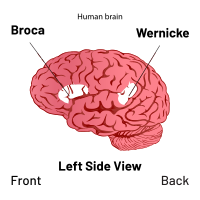
Photo from wikipedia
PURPOSE This study aimed to determine whether articulation assessment via telepractice is as reliable as in-person assessment. METHOD Thirty-four children aged 4-11 years with speech sound disorder (SSD) participated in… Click to show full abstract
PURPOSE This study aimed to determine whether articulation assessment via telepractice is as reliable as in-person assessment. METHOD Thirty-four children aged 4-11 years with speech sound disorder (SSD) participated in the study. The Articulation Subtest (SET) of the Turkish Articulation and Phonology Test (SST) was used to assess the children's articulation skills. The study's procedures comprised two stages. First, in the Baseline Pilot Stage, five speech-language pathologists (SLPs; four graduate SLPs and one SLP with a PhD degree) conducted in-person assessments on seven children, and their agreement was examined (α for five SLPs = .950; p < .0001). In the Main Assessment Stage, four SLPs assessed 27 children synchronously on four separate days through either online (two SLPs) or in-person (the other two SLPs) clinician roles, which changed daily. Online evaluators did not use microphones and headphones to avoid any advantage. The agreement among the four raters was examined by calculating the intraclass correlation coefficient. RESULTS The results revealed an excellent level of agreement regarding overall assessment between online and in-person clinicians (p < .0001). All articulation manners were acceptable, good, or excellent. However, some sounds' (α < .7 for /d/, /ɣ/, /b/; α < .8 for /p/, /ʃ/, /t/, /l/, /v/) reliability levels were relatively low compared with others. CONCLUSIONS There may be certain restrictiveness regarding discriminating visual or auditory clues related to certain phonemes in a telepractice environment. This restrictiveness may be related with sonority and with differentiation between minimal pairs where visual clues are limited.
Journal Title: American journal of speech-language pathology
Year Published: 2023
Link to full text (if available)
Share on Social Media: Sign Up to like & get
recommendations!